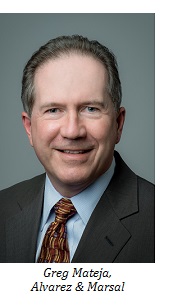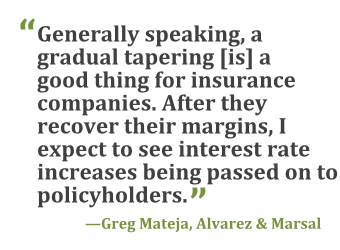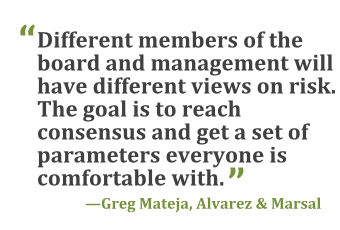 The Federal Reserve announced in December that it will reduce its bond purchasesfrom $85 billion to $75 billion per month, starting the process ofscaling back its massive quantitative easing program. In mid-2013,interest rates headed up as investors anticipated that thistapering would begin soon. Yield on 10-year Treasury notes rosefrom 1.61 percent in May to as high as 3 percent in September. Mosteconomists agree that the tapering program will continue to driverates skyward.
The Federal Reserve announced in December that it will reduce its bond purchasesfrom $85 billion to $75 billion per month, starting the process ofscaling back its massive quantitative easing program. In mid-2013,interest rates headed up as investors anticipated that thistapering would begin soon. Yield on 10-year Treasury notes rosefrom 1.61 percent in May to as high as 3 percent in September. Mosteconomists agree that the tapering program will continue to driverates skyward.
Treasury & Risk sat down with Greg Mateja,a managing director with Alvarez & Marsal and a fellow of theSociety of Actuaries, to discuss how higher interest rates arelikely to affect insurance companies and their customers. What wegot was good advice for every company contemplating the differentways in which tapering of the Fed's bond buying might affect theirbusiness.
|T&R: How will the tapering of theFed's quantitative easing program affect insurancecompanies?
|Greg Mateja: Insurance companies arebroad and diverse organizations, and it's quite hard to generalize.For that reason, treasurers and risk management professionalswithin insurance companies need to make sure they understand thespecifics of their business—their corporate structure, restrictionson liquidity, and how liquidity might be provided in times ofstress.
|Generally speaking, though, a gradual tapering and a gradualrise in interest rates are a good thing for insurance companies,ignoring any other changes that may occur in the rest of theeconomy. I think the first thing you would see is a restoration ofsome of the margins that have been squeezed in the past few yearsas insurers have come under pressure due to the low-interest-rateenvironment and guarantees on their policies. As rates rise andtheir portfolio turns over, their portfolio yields will increaseand their margins will expand, and generally that will be a goodthing. After they recover their margins, I would expect to seeinterest rate increases being passed on to policyholders throughincreased credited rates, and I think we might see some of thatmargin used to support growth as well.
T&R: Are there also risks toinsurance companies?
|GM: Well, this scenario could be altereddepending on what happens in the economy at large as a result ofFed tapering and interest rate hikes. People might reduce the levelof insurance they're buying or other things might happen that couldput pressure on insurance companies' margins. And if rates were torise significantly and suddenly, that could put liquidity pressureon the industry as policyholders look for alternatives. In manycases, insurance companies are carrying their assets at anamortized cost rather than marking them to market, and thatdifference might give rise to mark-to-market pressure for companieswith longer-duration assets and liabilities if rates risesignificantly and suddenly.
|T&R: What should companies do tomonitor the health of their insurance companies through thetapering process?
|GM: Certain types of products, such asseparate account products that are invested in specialized mutualfunds, are marked to market, so there is no concern with thosetypes of funds. But for other products, I would recommend lookingto the rating agencies, which do monitor these things as part oftheir process.
||
T&R: And what should a companydo—an insurance company or other type of business—to determinewhere it faces risks related to Fed tapering and the prospect ofrising interest rates?
| GM: I'm a fan ofstress testing, or scenario planning, the process by which peopledevelop an understanding of how their company's financials wouldreact under a set of targeted scenarios. What would happen if ratesrose at different rates of increase? You want to understand howdifferent levels of interest rates could impact each of yourbusiness units' risks, the interactions among the businesses, andthe company overall. If interest rates rise gradually—say, 100basis points a year for the next two or three years—what wouldhappen? And what if rates rise twice that fast?
GM: I'm a fan ofstress testing, or scenario planning, the process by which peopledevelop an understanding of how their company's financials wouldreact under a set of targeted scenarios. What would happen if ratesrose at different rates of increase? You want to understand howdifferent levels of interest rates could impact each of yourbusiness units' risks, the interactions among the businesses, andthe company overall. If interest rates rise gradually—say, 100basis points a year for the next two or three years—what wouldhappen? And what if rates rise twice that fast?
You want to assess those outcomes relative to the company's riskappetite and risk limits, its projected capital, and projections ofliquidity. You have to make sure you're comfortable with theresults of the stress test. That's a good way of doing basic riskmanagement for an insurance company.
|T&R: Isn't this also a riskmanagement best practice for companies outside the insurancesector?
|GM: Yes, as a general rule, companies aregoing to find that it's very helpful to have an understanding ofhow their businesses would react in different rate environments.They should pick a few scenarios and run stress tests. Even thoughI use the term 'stress test,' I don't mean companies should assumethere will be a major change in rates. They just have to decidewhat they think is a reasonable set of scenarios and understand howthose different scenarios might impact their business.
|The key is to make sure you're looking at the risks that areimportant to your mix of businesses and that you understand whatthe full range of impacts from those could be. This is fundamentalto any good risk management program.
|T&R: What are the keyconsiderations for companies in determining their riskappetite?
|GM: The appetite for risk tends to comefrom the top. A chief risk officer or other executive responsiblefor risk management would talk to members of the board and seniormanagement to get a feel for the kinds of risks or financialmovement that would cause concern. This is typically an iterativeprocess, and different organizations do it in different ways.
||Board members and senior management may be more responsive tospecific scenarios, so it may be helpful to take a draft proposalof a framework for their company's risk appetite to theorganization's leaders and say, 'Hey, if this event happened and wehad a loss of X dollars, how would you feel about that?' Then theyhave to triangulate with people because different members of theboard and senior management will have different views on risk. Thegoal is to bring all those different people together, reachconsensus, and get a set of parameters that everyone is relativelycomfortable with.
| As part of the process, some companieswill perform stochastic analyses and consider results at a targetedlevel such as a 90th or a 99th percentile as part of thedevelopment of their stress tests. These stochastic models arecomplex, with some subjective elements, and they may not beeffective for all risks. For an annual model, this could result ina risk constraint expressed as not wanting to lose more than Xdollars once every 10 years or 100 years. In the end, there shouldbe consideration of both magnitude and likelihood of potentialrisk.
As part of the process, some companieswill perform stochastic analyses and consider results at a targetedlevel such as a 90th or a 99th percentile as part of thedevelopment of their stress tests. These stochastic models arecomplex, with some subjective elements, and they may not beeffective for all risks. For an annual model, this could result ina risk constraint expressed as not wanting to lose more than Xdollars once every 10 years or 100 years. In the end, there shouldbe consideration of both magnitude and likelihood of potentialrisk.
T&R: So, where should companiesstart the stress testing for the current round of Fed tapering? Isit reasonable to evaluate the effects of an interest rate increaseof 100 basis points? 200 basis points?
|GM: Companies need to determine what theythink is likely in terms of a modest increase based on what they'veheard. Different people will have different perspectives on what'sreasonable. I'm not going to speculate about what the government'sgoing to do nor about how interest rates are going to respond, butI don't think most people would expect a gradual tapering to resultin rates that are rising by 300 basis points a year for fiveyears.
|Now, there may be people who want to include a stress test withthat kind of rate increase anyway because they're concerned abouttheir business and want to know what would happen in the event of arapid rise in rates. They might come up with a scenario or two thatrepresent a much larger increase than they actually expect tohappen, a scenario that isn't likely but is possible. They mightthink, 'Rates have gone up this much in the past. It's not clearthat conditions now warrant this size of increase, but if it didhappen, what might it mean for us? How should we set ourselves upto deal with this scenario, should it occur?'
Complete your profile to continue reading and get FREE access to Treasury & Risk, part of your ALM digital membership.
Your access to unlimited Treasury & Risk content isn’t changing.
Once you are an ALM digital member, you’ll receive:
- Critical Treasury & Risk information including in-depth analysis of treasury and finance best practices, case studies with corporate innovators, informative newsletters, educational webcasts and videos, and resources from industry leaders.
- Exclusive discounts on ALM and Treasury & Risk events.
- Access to other award-winning ALM websites including PropertyCasualty360.com and Law.com.
*May exclude premium content
Already have an account? Sign In
© 2024 ALM Global, LLC, All Rights Reserved. Request academic re-use from www.copyright.com. All other uses, submit a request to [email protected]. For more information visit Asset & Logo Licensing.







